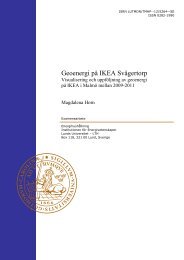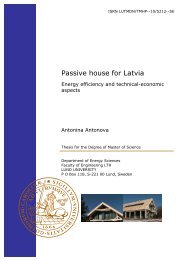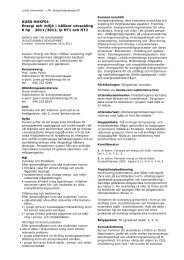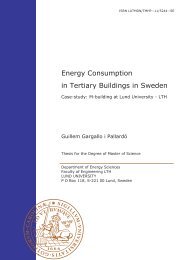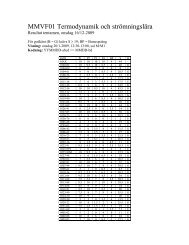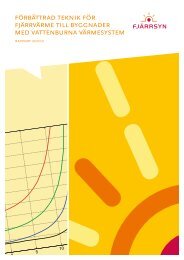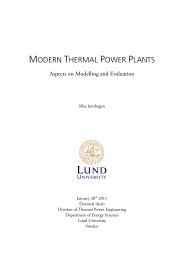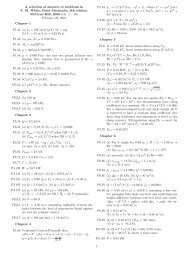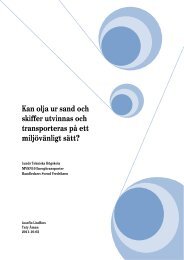a turbine-driven circulation pump in a district heating substation
a turbine-driven circulation pump in a district heating substation
a turbine-driven circulation pump in a district heating substation
Create successful ePaper yourself
Turn your PDF publications into a flip-book with our unique Google optimized e-Paper software.
Proceed<strong>in</strong>gs of ECOS 2009<br />
Copyright © 2009 by ABCM<br />
22 nd International Conference on Efficiency, Cost, Optimization<br />
Simulation and Environmental Impact of Energy Systems<br />
August 31 – September 3, 2009, Foz do Iguaçu, Paraná, Brazil<br />
A TURBINE-DRIVEN CIRCULATION PUMP IN A DISTRICT HEATING<br />
SUBSTATION<br />
Janusz Wollerstrand, janusz.wollerstrand@energy.lth.se<br />
Patrick Lauenburg, Patrick.lauenburg@energy.lth.se<br />
Svend Frederiksen, svend.frederiksen@energy.lth.se<br />
Dept. of Energy Sciences, Faculty of Eng<strong>in</strong>eer<strong>in</strong>g, Lund University<br />
Abstract. The paper describes the idea of a <strong>circulation</strong> <strong>pump</strong> <strong>in</strong> the radiator system powered by a <strong>turb<strong>in</strong>e</strong> placed on the<br />
primary side of a <strong>district</strong> heat<strong>in</strong>g (DH) <strong>substation</strong>. In this way, the pressure difference between the supply and return<br />
pipes is utilized to drive the <strong>circulation</strong> on the secondary (house-<strong>in</strong>ternal) side. The idea is to utilize the redundant<br />
differential pressure that exists <strong>in</strong> most DH <strong>substation</strong>s (because of the m<strong>in</strong>imum pressure difference that must be<br />
ma<strong>in</strong>ta<strong>in</strong>ed everywhere <strong>in</strong> the grid) to drive the <strong>turb<strong>in</strong>e</strong>. There are two ma<strong>in</strong> ideas here; one is that this can serve as a<br />
fallback solution <strong>in</strong> order to ensure heat supply dur<strong>in</strong>g a power failure. If only the DH provider can ma<strong>in</strong>ta<strong>in</strong> the<br />
operation of the grid by us<strong>in</strong>g backup power, customers will be able to receive heat. In a previous study, we showed<br />
that <strong>in</strong> many build<strong>in</strong>gs between 40 and 80 percent of the heat supply can be ma<strong>in</strong>ta<strong>in</strong>ed by natural <strong>circulation</strong> <strong>in</strong> the<br />
DH connected radiator systems. However, one cannot count on that natural <strong>circulation</strong> works satisfactorily <strong>in</strong> all<br />
build<strong>in</strong>gs. The proposed <strong>turb<strong>in</strong>e</strong> device could serve as a fallback arrangement <strong>in</strong> those build<strong>in</strong>gs. The second idea is to<br />
exam<strong>in</strong>e whether the <strong>turb<strong>in</strong>e</strong>-<strong>pump</strong> device can operate cont<strong>in</strong>uously. Many <strong>substation</strong>s have a redundant differential<br />
pressure which, when utilized <strong>in</strong> the <strong>turb<strong>in</strong>e</strong>-<strong>pump</strong>, can imply a sav<strong>in</strong>g of electrical energy. A prototype has been<br />
developed <strong>in</strong> co-operation with a <strong>pump</strong> manufacturer. It has been tested as well <strong>in</strong> laboratory as <strong>in</strong> a DH <strong>substation</strong>.<br />
The <strong>turb<strong>in</strong>e</strong>-<strong>pump</strong> proved to work as backup system <strong>in</strong> a DH connected radiator system (if the operation of the DH grid<br />
is ma<strong>in</strong>ta<strong>in</strong>ed) but further studies are needed to explore the opportunities for cont<strong>in</strong>uous operation. S<strong>in</strong>ce the flow ratio<br />
between primary and secondary side varies with the heat load, it may be difficult to use a <strong>turb<strong>in</strong>e</strong>-<strong>pump</strong> with direct<br />
connection from primary to secondary side. One should consider a hydraulic bypass of the <strong>turb<strong>in</strong>e</strong>, possibly<br />
supplemented with an electrical connection between primary and secondary side through a generator and electric<br />
motor, preferably with a connection to the power grid.<br />
Keywords: <strong>district</strong> heat<strong>in</strong>g, <strong>turb<strong>in</strong>e</strong>-<strong>driven</strong> <strong>pump</strong>, secure heat supply<br />
1. INTRODUCTION<br />
This paper presents results from empirical tests of a prototype of a concept where the <strong>circulation</strong> <strong>pump</strong> <strong>in</strong> a radiator<br />
system is <strong>driven</strong> by a <strong>turb<strong>in</strong>e</strong>, which <strong>in</strong> turn is <strong>driven</strong> by the differential pressure <strong>in</strong> a <strong>district</strong> heat<strong>in</strong>g (DH) network. The<br />
concept is an alternative, or complement, to the arrangement that is normally used with an <strong>in</strong>direct connection of a<br />
build<strong>in</strong>g to a DH network. Indirect connection refers to that there is a heat exchanger (HEX) provid<strong>in</strong>g hydraulic<br />
separation of the radiator circuit from the DH network.<br />
Normally, the <strong>circulation</strong> <strong>pump</strong> <strong>in</strong> a radiator system is powered by an electric motor. The DH flow to the HEX is<br />
normally throttled by a control valve <strong>in</strong> series with the HEX, <strong>in</strong> which case one could say, that a large part of the<br />
differential pressure (between the supply and return pipe) <strong>in</strong> the DH network is not used, as it will be under the<br />
proposed concept.<br />
Obviously, the throttl<strong>in</strong>g does not mean that energy is lost <strong>in</strong> the sense of the first law of thermodynamics; the<br />
<strong>circulation</strong> <strong>pump</strong>s convert electrical energy to work, which <strong>in</strong> turn is converted to heat energy due to friction losses is<br />
pipes, heat exchangers, and valves. When control valves <strong>in</strong> <strong>substation</strong>s throttle the flow, it does not cause energy to<br />
leave the system. However, it does imply a loss of exergy <strong>in</strong> the sense of the second law of thermodynamics, because<br />
useful work is converted to heat [1]. The concept means that less electricity, as a whole, needs to be added to the<br />
system, s<strong>in</strong>ce the <strong>turb<strong>in</strong>e</strong> <strong>pump</strong> implies a recovery of work, and an otherwise <strong>in</strong>evitable exergy loss can be reduced.<br />
Orig<strong>in</strong>ally, the idea was proposed 10 years ago, <strong>in</strong>dependently of each other, by R. Jonson <strong>in</strong> a Swedish patent<br />
application [3] and by S. Frederiksen, Lund University. The concept has been termed ”Autonomous District Heat<strong>in</strong>g”<br />
and has the potential to both ensure the <strong>circulation</strong> dur<strong>in</strong>g a power failure, and to save electricity by cont<strong>in</strong>uous<br />
operation of the <strong>circulation</strong> <strong>pump</strong>. The concept was previously presented at the 11th International Symposium of<br />
District Heat<strong>in</strong>g and Cool<strong>in</strong>g 2008 <strong>in</strong> Reykjavik [2].<br />
This paper presents results from empirical tests of a prototype based on the concept. The prototype has been<br />
manufactured by our <strong>in</strong>dustrial partner <strong>in</strong> consultation with us. They have tested the prototype <strong>in</strong> their laboratory, and<br />
we have tested it <strong>in</strong> a field study, where the prototype was placed <strong>in</strong> a build<strong>in</strong>g that is connected to the DH network <strong>in</strong><br />
Gothenburg.<br />
2. NATURAL CIRCULATION<br />
In a recent project, together with E.ON <strong>in</strong> Malmö, the Swedish Energy Agency, the Swedish District Heat<strong>in</strong>g<br />
Association and a local real estate company <strong>in</strong> Malmö, we studied the possibilities to ma<strong>in</strong>ta<strong>in</strong> the heat supply dur<strong>in</strong>g a
power failure [4]. The work exam<strong>in</strong>ed whether natural <strong>circulation</strong> can arise <strong>in</strong> the connected build<strong>in</strong>gs, given that the<br />
operation of the DH network can be ma<strong>in</strong>ta<strong>in</strong>ed. Several build<strong>in</strong>gs were tested and the results have been surpris<strong>in</strong>gly<br />
positive: <strong>in</strong> many build<strong>in</strong>gs, between 40 and 80 percent of the heat supply can be ma<strong>in</strong>ta<strong>in</strong>ed through natural<br />
<strong>circulation</strong>. The study however showed that one cannot assume that this works satisfactorily <strong>in</strong> all build<strong>in</strong>gs. The<br />
proposed device could act as fallback arrangement <strong>in</strong> these build<strong>in</strong>gs.<br />
3. TURBINE DRIVEN CIRCULATION PUMP<br />
Figure 1 shows the radiator system part of a DH <strong>substation</strong> with the proposed device <strong>in</strong> its simplest form, the <strong>turb<strong>in</strong>e</strong><br />
and the <strong>pump</strong> on a common shaft, here with the <strong>turb<strong>in</strong>e</strong> <strong>in</strong> series with the radiator HEX.<br />
Δp DH<br />
Radiator<br />
HEX<br />
Radiator<br />
system<br />
Turb<strong>in</strong>e<br />
Pump<br />
Figure 1. Schematic picture of the space heat<strong>in</strong>g part of a DH <strong>substation</strong> with the <strong>circulation</strong> <strong>pump</strong> <strong>driven</strong> by a water<br />
<strong>turb<strong>in</strong>e</strong> on the primary side.<br />
The l<strong>in</strong>k between the <strong>turb<strong>in</strong>e</strong> and the <strong>pump</strong> can be arranged <strong>in</strong> different ways. As <strong>in</strong> the figure, one can have a<br />
simple mechanical coupl<strong>in</strong>g, possibly with a gear. Another option would be to let the <strong>turb<strong>in</strong>e</strong> drive a generator, which <strong>in</strong><br />
turn supplies the <strong>pump</strong> with electrical energy. A hybrid solution is also possible, where the mechanical coupl<strong>in</strong>g is<br />
comb<strong>in</strong>ed with an electric motor that also can function as generator. Some of the factors that determ<strong>in</strong>e which<br />
configuration is most appropriate are:<br />
• Optimum speeds of <strong>turb<strong>in</strong>e</strong> and <strong>pump</strong> shafts<br />
• The differential pressure on the primary side vs. flow needs <strong>in</strong> the secondary side<br />
• Transmission losses, if generator and motor are used<br />
• Robustness<br />
• Price<br />
The potential for the <strong>turb<strong>in</strong>e</strong> power to be sufficient to operate the <strong>circulation</strong> <strong>pump</strong> can be estimated by the<br />
follow<strong>in</strong>g example. The total required efficiency of the <strong>turb<strong>in</strong>e</strong> <strong>pump</strong> can be described as<br />
( V&<br />
⋅Δp)<br />
(<br />
& ⋅Δ )<br />
P P<br />
ηtot = η<strong>turb<strong>in</strong>e</strong> ⋅ η<strong>pump</strong><br />
= ⋅ =<br />
P P V p<br />
shaft hydr,<br />
rad rad<br />
hydr,<br />
DH<br />
shaft<br />
DH<br />
. (1)<br />
The energy balance for the transferred energy <strong>in</strong> the radiator HEX<br />
( ρ p ) ( ρ p )<br />
Q & = ⋅V & ⋅c ⋅Δ T = ⋅V & ⋅c ⋅ΔT<br />
(2)<br />
can be simplified to<br />
DH<br />
rad<br />
V&<br />
V&<br />
rad<br />
DH<br />
ΔT<br />
= Δ T<br />
DH<br />
rad<br />
. (3)<br />
When <strong>in</strong>serted <strong>in</strong> the expression for the efficiency, we obta<strong>in</strong>
Proceed<strong>in</strong>gs of ECOS 2009<br />
Copyright © 2009 by ABCM<br />
22 nd International Conference on Efficiency, Cost, Optimization<br />
Simulation and Environmental Impact of Energy Systems<br />
August 31 – September 3, 2009, Foz do Iguaçu, Paraná, Brazil<br />
η<br />
tot<br />
ΔTDH<br />
Δp<br />
= ⋅<br />
ΔT<br />
Δp<br />
rad<br />
rad<br />
DH<br />
. (4)<br />
Let us assume a specific case where the <strong>in</strong>com<strong>in</strong>g and outgo<strong>in</strong>g DH temperatures are 100 and 45°C, respectively,<br />
and the temperature <strong>in</strong>creases from 40 to 60°C <strong>in</strong> the radiator system. If we also assume that, the differential pressure<br />
for the <strong>turb<strong>in</strong>e</strong> on the primary side is 4 bars and the <strong>circulation</strong> <strong>pump</strong> provides a pressure <strong>in</strong>crease of 0.3 bars, it means<br />
that the total efficiency must be:<br />
η tot<br />
( − )<br />
( − )<br />
100 45 0,3<br />
= ⋅ ≈ 21% . (5)<br />
60 40 4<br />
This could for example be achieved with a <strong>turb<strong>in</strong>e</strong> efficiency of 30 per cent and a <strong>pump</strong> efficiency of 70 per cent<br />
accord<strong>in</strong>g to:<br />
ηtot = η<strong>turb<strong>in</strong>e</strong> ⋅ η<strong>pump</strong><br />
= 0,7 ⋅ 0,3 = 21%<br />
(6)<br />
The example shows that the device can function even when conditions vary greatly at different operat<strong>in</strong>g cases. We<br />
will discuss this further later on.<br />
3.1. Pumps as <strong>turb<strong>in</strong>e</strong>s (PAT)<br />
It may seem expensive to <strong>in</strong>stall a water <strong>turb<strong>in</strong>e</strong> <strong>in</strong> each DH <strong>substation</strong>. However, it appears that it could be possible<br />
to use exist<strong>in</strong>g, simple, series-produced <strong>pump</strong>s for the purpose. There have been some studies on a concept known as<br />
PAT (Pumps As Turb<strong>in</strong>es), see [8] and [5]. It turns out that small <strong>pump</strong>s can be run <strong>in</strong>verted, as <strong>turb<strong>in</strong>e</strong>s, with a<br />
reasonably high efficiency. Typical applications for such <strong>turb<strong>in</strong>e</strong>s so far have been <strong>in</strong> small hydroelectric power stations<br />
to serve <strong>in</strong>dividual build<strong>in</strong>gs near a river or a stream that are not connected to a reliable public power grid.<br />
One of the reasons that make the PAT concept attractive is that small <strong>pump</strong>s can be purchased ready-made almost<br />
anywhere <strong>in</strong> the world. If there is a desire to <strong>in</strong>crease the <strong>pump</strong> efficiency, it can be achieved by round<strong>in</strong>g off the <strong>pump</strong><br />
blades’ edges at the outlet (which becomes the <strong>in</strong>let when operated as <strong>turb<strong>in</strong>e</strong>).<br />
As a general term, very small <strong>turb<strong>in</strong>e</strong>s, with a power below 5 kW, are known as piko <strong>turb<strong>in</strong>e</strong>s. Examples of such can<br />
be found <strong>in</strong>, for example, Indonesia [6] and Kenya [7].<br />
3.2. Prototype and test rig<br />
In cooperation with a <strong>pump</strong> manufacturer, a prototype of a <strong>turb<strong>in</strong>e</strong>-<strong>driven</strong> <strong>pump</strong> has been constructed. The prototype<br />
is of a purely mechanical type, with a common shaft, and is shown <strong>in</strong> Figure 1. The <strong>turb<strong>in</strong>e</strong>-<strong>pump</strong> was built by the <strong>pump</strong><br />
manufacturer and tested <strong>in</strong> their laboratory. After that, it was <strong>in</strong>stalled <strong>in</strong> a DH <strong>substation</strong> <strong>in</strong> Gothenburg. The purpose<br />
of the field test was to see how the device fits <strong>in</strong> a DH <strong>substation</strong> environment, regard<strong>in</strong>g both size and performance.<br />
A larger build<strong>in</strong>g owned by Göteborgs Energi AB (GE), which serves as their head office, was chosen for this<br />
purpose, depend<strong>in</strong>g on confidentiality requirements that would be difficult to achieve if the prototype was put <strong>in</strong> a<br />
build<strong>in</strong>g with outside owners. The choice of the build<strong>in</strong>g has <strong>in</strong>fluenced the design and outcome of the experiment to<br />
some extent, which will be discussed later on.<br />
The exist<strong>in</strong>g <strong>substation</strong> consists of a radiator circuit, a ventilation circuit and a domestic hot water circuit. Figure 2<br />
shows the circuits’ respective HEXs and associated control valves.<br />
S<strong>in</strong>ce the build<strong>in</strong>g is relatively large, its radiator circuit is divided <strong>in</strong>to four sections, each with its own associated<br />
valve group and <strong>circulation</strong> <strong>pump</strong> (furthest to the right <strong>in</strong> Figure 2). The exist<strong>in</strong>g valve group configuration is shown <strong>in</strong><br />
Figure 3.<br />
The orig<strong>in</strong>al idea was to connect the prototype <strong>in</strong> series with the radiator HEX and control valve. This became<br />
impossible because the differential pressure <strong>in</strong> GE's network was found to be surpris<strong>in</strong>gly low <strong>in</strong> the central part of the<br />
town where the build<strong>in</strong>g is located, typically 1-3 bars. With a series connection, the available differential pressure<br />
across the <strong>turb<strong>in</strong>e</strong> would be far too low, s<strong>in</strong>ce the pressure drop across the HEX and control valve would reduce it.<br />
Furthermore, because of the use of valve groups, the flow resistance on the secondary side could vary dur<strong>in</strong>g the tests.
Figure 2. DH <strong>substation</strong> by Göteborgs Energi AB.<br />
Figure 3. Valve group, before conversion.<br />
Therefore, we decided to use only one of the valve groups as secondary circuit and to connect the <strong>turb<strong>in</strong>e</strong> directly to<br />
the DH pipes, see Figure 4. The prototype was connected so that the <strong>pump</strong> part replaced the exist<strong>in</strong>g <strong>circulation</strong> <strong>pump</strong>.<br />
The connection was made us<strong>in</strong>g flexible hoses. Two flowmeters were <strong>in</strong>stalled to measure the primary and secondary<br />
flow through the <strong>turb<strong>in</strong>e</strong> <strong>pump</strong>.<br />
The valve group that serves the basement was chosen for the tests, <strong>in</strong> order to m<strong>in</strong>imize any effect on the operation<br />
of the build<strong>in</strong>g. The flexible hoses and the valve group’s appearance without protective cover can be seen <strong>in</strong> Figure 5.<br />
We could control the flow resistance on the primary and secondary side by means of shut-off valves. A test run showed<br />
that the flow resistance on the secondary side was too large relative to the <strong>turb<strong>in</strong>e</strong>-<strong>pump</strong>’s capacity. Therefore, an<br />
additional bypass between the <strong>pump</strong> <strong>in</strong>let and outlet was arranged (not <strong>in</strong> picture). In this way, more relevant operat<strong>in</strong>g<br />
conditions could be tested. The tests were run at five different flow resistances.<br />
The tests began by choos<strong>in</strong>g a flow resistance on the secondary side. Then a shut-off valve on the primary side was<br />
opened gradually until a desired <strong>pump</strong> speed was achieved. When the state was stable, differential pressure and flow<br />
rate on primary and secondary sides were registered. The differential pressure was read directly from the <strong>in</strong>stalled<br />
pressure gauges and the flow was measured with an ultrasonic flowmeter from Kamstrup.<br />
A difficulty was, as already mentioned, that the differential pressure <strong>in</strong> the DH network was quite low while we did<br />
our tests, and tends to be low <strong>in</strong> that part of the network throughout the year. For this reason, secondary flows of a<br />
certa<strong>in</strong> magnitude could not be achieved because the <strong>pump</strong> speed could not be <strong>in</strong>creased although the shut-off valve on<br />
the primary side was completely open. Another difficulty was that the differential pressure varies a lot <strong>in</strong> the DH<br />
network from time to time. Therefore, it was difficult to achieve completely steady states (constant <strong>pump</strong> speed). This<br />
has affected the measurement accuracy more than the fact that relatively simple equipment was used for pressure<br />
measurement.<br />
To/from other radiator<br />
circuits<br />
To/from radiator circuit<br />
DH<br />
ΔT<br />
Δp<br />
Valve group <strong>pump</strong>:<br />
Orig<strong>in</strong>al location<br />
New location<br />
Rad<br />
HEX<br />
TA-flow<br />
Δp<br />
Valve group<br />
Figure 4. Connection scheme of the <strong>turb<strong>in</strong>e</strong> <strong>pump</strong> <strong>in</strong>stallation <strong>in</strong><br />
the <strong>substation</strong>.<br />
Figure 5. Valve group without protective cover, after<br />
the conversion.
Proceed<strong>in</strong>gs of ECOS 2009<br />
Copyright © 2009 by ABCM<br />
22 nd International Conference on Efficiency, Cost, Optimization<br />
Simulation and Environmental Impact of Energy Systems<br />
August 31 – September 3, 2009, Foz do Iguaçu, Paraná, Brazil<br />
4. RESULTS<br />
4.1. Pump curves<br />
Figure 6 shows the <strong>pump</strong> and system curves that were compiled from the experiments <strong>in</strong> Gothenburg. Different<br />
primary flows result <strong>in</strong> different <strong>pump</strong> speeds. The different system curves have been achieved by chang<strong>in</strong>g the radiator<br />
system characteristics us<strong>in</strong>g both a balanc<strong>in</strong>g valve to <strong>in</strong>crease the system’s flow resistance, as well as with the bypass<br />
connection that reduces the relatively high flow resistance by allow<strong>in</strong>g a part of the flow to bypass the radiator circuit.<br />
The steepest curve corresponds to a case where the resistance was <strong>in</strong>creased (System 1), while the second-steepest<br />
system curve represents the orig<strong>in</strong>al system (System 2). The rema<strong>in</strong><strong>in</strong>g curves are variants <strong>in</strong> which the resistance has<br />
been reduced by gradually open<strong>in</strong>g the bypass connection. In the regular system (System 2), the radiator flow at normal<br />
operation was between 0.61 and 0.625 l/s. The figure shows that this flow was not quite reached dur<strong>in</strong>g the test. At the<br />
maximum primary flow through the <strong>turb<strong>in</strong>e</strong> <strong>pump</strong>, a radiator flow of 0.56 l/s was reached.<br />
4.2. Secur<strong>in</strong>g heat supplies<br />
The <strong>pump</strong> curves show that the <strong>turb<strong>in</strong>e</strong> <strong>pump</strong> as such works <strong>in</strong> the tested environment. The question is whether it<br />
provides enough flow at different operat<strong>in</strong>g cases. Let us first study the possibilities of us<strong>in</strong>g the <strong>turb<strong>in</strong>e</strong> <strong>pump</strong> as<br />
backup device <strong>in</strong> case of a power failure.<br />
Dur<strong>in</strong>g the test, about 90 percent of the normal radiator flow was reached. S<strong>in</strong>ce the radiator flow and radiator<br />
system characteristic normally are more or less constant, the flow is determ<strong>in</strong>ed by the current differential pressure and<br />
flow on the primary side. The primary differential pressure varies with the ambient temperature and depends on the DH<br />
network and the DH production characteristics. At the lowest ambient temperature, the differential pressure has its<br />
maximum, which is favorable to achieve a sufficiently high speed of the <strong>turb<strong>in</strong>e</strong> <strong>pump</strong>. It can therefore be recognized<br />
that, with the current configuration, one clearly has an adequate backup solution.<br />
The maximum available primary flow is not entirely obvious. In the present <strong>in</strong>stallation, the <strong>turb<strong>in</strong>e</strong> <strong>pump</strong> is<br />
connected <strong>in</strong> parallel with the radiator HEX allow<strong>in</strong>g a high flow through the <strong>turb<strong>in</strong>e</strong>. In a further perspective, <strong>in</strong> which<br />
<strong>turb<strong>in</strong>e</strong> <strong>pump</strong>s are present at several locations <strong>in</strong> a DH network, this configuration means that the <strong>turb<strong>in</strong>e</strong> can "steal"<br />
flow from other DH <strong>substation</strong>s <strong>in</strong> the network. This means that one has to add more <strong>pump</strong> energy to the network. By<br />
<strong>in</strong>stall<strong>in</strong>g the <strong>turb<strong>in</strong>e</strong> <strong>in</strong> series with the radiator HEX, one can avoid this by allow<strong>in</strong>g the <strong>turb<strong>in</strong>e</strong> <strong>pump</strong> to receive the<br />
flow determ<strong>in</strong>ed by the radiator system’s heat load.<br />
The radiator circuit <strong>in</strong> question is designed for 56 kW and a temperature program of 80/60°C. This means that the<br />
radiator flow is 0.67 l/s 1 , which is roughly <strong>in</strong> l<strong>in</strong>e with what was noted <strong>in</strong> the tests. S<strong>in</strong>ce the primary side is designed<br />
for 100/63°C, the maximum primary flow rate is 0.36 l/s.<br />
Figure 7 shows the radiator flow as a function of the DH heat flow for each test. Regardless of the flow resistance<br />
<strong>in</strong> the radiator system, a DH flow rate of approximately 0.4 l/s is required to get a flow <strong>in</strong> the radiator system. This<br />
<strong>in</strong>dicates that there is friction <strong>in</strong> the <strong>turb<strong>in</strong>e</strong> <strong>pump</strong> that results <strong>in</strong> an offset error at all operat<strong>in</strong>g cases.<br />
Dps [bar]<br />
0.6<br />
0.5<br />
0.4<br />
0.3<br />
0.2<br />
700 rpm 1200 rpm 1700 rpm 1900 rpm<br />
2200 rpm 2400 rpm System 1 System 2<br />
System 3 System 4 System 5<br />
V s [l/s]<br />
1.6<br />
1.4<br />
1.2<br />
1.0<br />
0.8<br />
0.6<br />
0.4<br />
System 1<br />
System 2<br />
System 3<br />
System 4<br />
System 5<br />
0.1<br />
0.2<br />
0.0<br />
0.0 0.2 0.4 0.6 0.8 1.0 1.2 1.4 1.6<br />
Vs [l/s]<br />
Figure 6. Pump and system curves from field tests <strong>in</strong><br />
Gothenburg.<br />
0.0<br />
0.0 0.5 1.0 1.5 2.0 2.5 3.0<br />
V p [l/s]<br />
Figure 7. Due to friction <strong>in</strong> the <strong>turb<strong>in</strong>e</strong> <strong>pump</strong>, a primary flow<br />
of at least 0.4 l/s is required for a flow on the<br />
secondary side to arise.<br />
1 56<br />
Q& rad = ρ ⋅V& ⋅cp<br />
⋅ΔT ⇒ V& = = 0.67 l/s<br />
4.18 ⋅(80 −60)
Should the prototype of the <strong>turb<strong>in</strong>e</strong> <strong>pump</strong> be placed <strong>in</strong> series with the radiator HEX it can be concluded that the required<br />
heat<strong>in</strong>g flow for the radiator HEX is not enough even to get the <strong>pump</strong> to beg<strong>in</strong> to rotate (0.36 < 0.4 l/s). Discussions<br />
with the <strong>pump</strong> manufacturer <strong>in</strong>dicate that it is possible to reduce the friction significantly with the right choice of<br />
components and technical solutions. Furthermore, the prototype is substantially oversized: the <strong>pump</strong> can, at full speed,<br />
provide a flow of 5.6 l/s at 50 kPa pressure drop on the secondary side. In a smaller <strong>pump</strong>, the effect of friction would<br />
be less under the given conditions. It is therefore relevant to analyze the <strong>turb<strong>in</strong>e</strong> <strong>pump</strong>’s performance under the<br />
assumption that the friction can be neglected. In such a case, the curves <strong>in</strong> Figure 7 are moved to the left so that the<br />
l<strong>in</strong>es would co<strong>in</strong>cide at the orig<strong>in</strong>.<br />
4.3. Cont<strong>in</strong>ouos operation of a <strong>turb<strong>in</strong>e</strong> <strong>pump</strong><br />
Over the years, <strong>pump</strong> manufacturers have made efforts to improve the effeciency of their products to help save<br />
electricity. The idea of hav<strong>in</strong>g a <strong>pump</strong> <strong>driven</strong> by a <strong>turb<strong>in</strong>e</strong> would be a major, <strong>in</strong>direct step forward <strong>in</strong> this development<br />
because it uses energy that would otherwise be lost by throttl<strong>in</strong>g <strong>in</strong> the control valves connected <strong>in</strong> series with HEXs.<br />
Figure 8 below shows a simplified schematic view of the pressure change from a <strong>pump</strong> located centrally <strong>in</strong> the<br />
network, to the network's periphery. The pressure difference between the supply and return pipe is much larger near the<br />
<strong>pump</strong> compared to the periphery of the network.<br />
With reference to the previous section, there is a potential to use the <strong>turb<strong>in</strong>e</strong> <strong>pump</strong> for cont<strong>in</strong>uous operation. Apart<br />
from the offset error due to friction <strong>in</strong> the <strong>turb<strong>in</strong>e</strong> <strong>pump</strong>, a secondary flow was recieived significantly lower than the<br />
primary flow. A <strong>turb<strong>in</strong>e</strong> <strong>pump</strong> for cont<strong>in</strong>uous operation requires very careful design. Depend<strong>in</strong>g on the characteristics<br />
of different radiator systems the conditions vary how well a <strong>turb<strong>in</strong>e</strong> <strong>pump</strong> can operate. Figure 9 below shows how the<br />
relationship between primary and secondary flow usually differs between different types of radiator systems. Best<br />
conditions are achieved <strong>in</strong> a low-flow system, 80/35°C <strong>in</strong> the figure, where the radiator flow is considerably lower than<br />
<strong>in</strong> a 60/40°C system. The highest secondary flow is found <strong>in</strong> a 55/45°C system, which is most demand<strong>in</strong>g for the<br />
<strong>turb<strong>in</strong>e</strong> <strong>pump</strong>.<br />
In addition to a careful design, it may be necessary to use a different gear to obta<strong>in</strong> the correct relationship between<br />
the primary and secondary flows. As the flow ratio also varies with the heat load, it may be difficult to use a <strong>turb<strong>in</strong>e</strong><br />
<strong>pump</strong> with direct connection. In this case, an <strong>in</strong>direct l<strong>in</strong>k with generator and motor could be <strong>in</strong>terest<strong>in</strong>g.<br />
pm<strong>in</strong><br />
p m ax<br />
He at<br />
plant<br />
Figure 8. Pr<strong>in</strong>ciple sketch show<strong>in</strong>g the pressure variation<br />
across DH <strong>substation</strong>s from a centrally located<br />
<strong>pump</strong> to the network's periphery.<br />
Flow relation V s /V p [-]<br />
20<br />
18<br />
16<br />
14<br />
12<br />
10<br />
8<br />
6<br />
4<br />
2<br />
0<br />
55 45<br />
60 40<br />
80 35<br />
-15 -10 -5 0 5 10 15<br />
Outdoor temperature [°C]<br />
Figure 9. The relationship between primary and secondary<br />
flow depend<strong>in</strong>g on the outdoor temperature <strong>in</strong><br />
different types of radiator systems.<br />
5. RESULTS FROM THE PUMP MANUFACTURER<br />
As mentioned before, the prototype was tested by the <strong>pump</strong> manufacturer before it was <strong>in</strong>stalled <strong>in</strong> Gothenburg.<br />
The results of these tests co<strong>in</strong>cide with our results but are far more comprehensive, thanks to the fact that the<br />
manufacturer used a laboratory and thus had no difficulty <strong>in</strong> achiev<strong>in</strong>g the desired differential pressure across the<br />
<strong>turb<strong>in</strong>e</strong> section. The picture to the left <strong>in</strong> Figure 10 shows the results on the <strong>turb<strong>in</strong>e</strong> side, while the picture on the right<br />
shows the results on the <strong>pump</strong> side. Curves with the same color correspond to the same, roughly constant, shaft speed<br />
that was reached at the respective test series. One can see that at constant primary flow and shaft speed, the pressure<br />
drop across the <strong>turb<strong>in</strong>e</strong> varies rather little regardless of the load variation on the <strong>pump</strong> side. One can say that the<br />
<strong>turb<strong>in</strong>e</strong>’s throttl<strong>in</strong>g ability depends ma<strong>in</strong>ly on the primary flow and the pressure drop <strong>in</strong>creases with the square of the<br />
flow, as <strong>in</strong> a component with fixed flow resistance. The <strong>pump</strong> curves to the right looks typical for a centrifugal <strong>pump</strong>.<br />
Thanks to an appropriate choice of <strong>turb<strong>in</strong>e</strong> and <strong>pump</strong>, the <strong>turb<strong>in</strong>e</strong> is here work<strong>in</strong>g at a much higher pressure<br />
difference than the pressure head generated by the <strong>pump</strong>, but its flow need is only a third of the <strong>pump</strong> flow. This<br />
represents a typical situation <strong>in</strong> a <strong>substation</strong>. We can aga<strong>in</strong> try to determ<strong>in</strong>e if the <strong>turb<strong>in</strong>e</strong> <strong>pump</strong> is suitable for<br />
cont<strong>in</strong>uous operation.
Proceed<strong>in</strong>gs of ECOS 2009<br />
Copyright © 2009 by ABCM<br />
22 nd International Conference on Efficiency, Cost, Optimization<br />
Simulation and Environmental Impact of Energy Systems<br />
August 31 – September 3, 2009, Foz do Iguaçu, Paraná, Brazil<br />
Primary diff. pressure, bar<br />
6<br />
5<br />
4<br />
3<br />
2<br />
1<br />
0<br />
800 1400 2200 3000 3500<br />
800<br />
1400<br />
2250<br />
2100<br />
3050<br />
2800<br />
3600<br />
3300<br />
0 2 4 6 8 10<br />
Primary flow, m 3 /h<br />
Secondary pressure rise, bar<br />
1.2<br />
1.0<br />
0.8<br />
0.6<br />
0.4<br />
0.2<br />
0.0<br />
2200<br />
1400<br />
800<br />
300<br />
3500<br />
3500<br />
3000<br />
2200<br />
1400<br />
800<br />
0 5 10 15 20 25<br />
Secondary flow, m 3 /h<br />
Figure 10. Test results from <strong>pump</strong> manufacturer. Performance curves for the <strong>turb<strong>in</strong>e</strong> section to the left and for the <strong>pump</strong><br />
section to the right.<br />
In Figure 11, the same <strong>pump</strong> curves as <strong>in</strong> Figure 10 are plotted as a function of the ratio between the obta<strong>in</strong>ed<br />
secondary flow (<strong>pump</strong> flow) and the required primary flow (<strong>turb<strong>in</strong>e</strong> flow). Here we see the potential: up to 2.5 times<br />
depend<strong>in</strong>g on the necessary <strong>pump</strong> pressure head.<br />
Secondary pressure rise, bar<br />
1.2<br />
1.0<br />
0.8<br />
0.6<br />
0.4<br />
0.2<br />
0.0<br />
0% 50% 100% 150% 200% 250% 300%<br />
Secondary/primary flow [-]<br />
Figure 11. Pump curves where the pressure rise is plotted as a function of the relationship between <strong>pump</strong> flow and the<br />
<strong>turb<strong>in</strong>e</strong> flow.<br />
If this is compared with the curves <strong>in</strong> Figure 9, it appears, however, that such a flow ratio is not sufficient to run a<br />
radiator circuit dimensioned accord<strong>in</strong>g to a 60/40°C temperature program, except for very low outdoor temperatures.<br />
However, the situation is much better <strong>in</strong> the case of a low-flow system, 80/30°C. Here, the flow ratio is sufficient for<br />
outdoor temperatures up to around 5ºC. One must be aware that to achieve a constant <strong>circulation</strong> flow the <strong>turb<strong>in</strong>e</strong> <strong>pump</strong><br />
must ma<strong>in</strong>ta<strong>in</strong> a constant shaft speed, which requires a constant primary flow, which <strong>in</strong> turn goes aga<strong>in</strong>st the pr<strong>in</strong>ciple<br />
of the control of the radiator HEX (variable primary flow) when the <strong>turb<strong>in</strong>e</strong> <strong>pump</strong> should be conncted <strong>in</strong> series with the<br />
latter. To solve this problem, the <strong>turb<strong>in</strong>e</strong> <strong>pump</strong> needs to be designed to provide the adequate <strong>circulation</strong> flow at a given<br />
outdoor temperature and a bypass valve needs to be <strong>in</strong>stalled, allow<strong>in</strong>g a bypass flow that is superfluous for the <strong>pump</strong><br />
drive, but is necessary for heat supply at all lower temperatures.<br />
Generally, it is clear from Figure 9 that a <strong>turb<strong>in</strong>e</strong> <strong>pump</strong> with the discussed design can never run the radiator circuit<br />
throughout the entire operat<strong>in</strong>g range as the primary flow becomes very small at low loads. Some k<strong>in</strong>d of assistance will<br />
therefore always be needed at moderate outdoor temperatures. However, there are prospects for how the limit for<br />
<strong>turb<strong>in</strong>e</strong> <strong>pump</strong>-based operation can be moved towards higher outdoor temperatures:<br />
• The constructed prototype is not fully developed and consists of two standard <strong>pump</strong>s with a mechanical<br />
coupl<strong>in</strong>g between them.<br />
• The pressure rise <strong>in</strong> the radiator circuit was set to a typical value <strong>in</strong> our example. In a high-flow system<br />
adjusted as a low-flow system, this value would be considerably lower.<br />
• The discussion this far requires a radiator system with constant <strong>circulation</strong> flow. In a system with a variable<br />
flow, the flow would decl<strong>in</strong>e with decreas<strong>in</strong>g heat load, which would <strong>in</strong>crease the <strong>turb<strong>in</strong>e</strong> <strong>pump</strong>’s possible<br />
operat<strong>in</strong>g range further.<br />
Even under the conditions mentioned above, the operation of the <strong>turb<strong>in</strong>e</strong> <strong>pump</strong> would cover the majority of the<br />
radiator circuit’s operational time dur<strong>in</strong>g the year, which means sav<strong>in</strong>gs of electrical energy for the <strong>pump</strong> operation.
6. CONCLUSIONS<br />
If the ambition is to supply heat to all build<strong>in</strong>gs <strong>in</strong> the event of a power failure, the pressure variations across the<br />
network needs special attention. In places where there is a large pressure difference, the conditions for achiev<strong>in</strong>g a high<br />
efficiency <strong>in</strong> a <strong>turb<strong>in</strong>e</strong>-<strong>driven</strong> <strong>pump</strong> are better than elsewhere. If the <strong>turb<strong>in</strong>e</strong> <strong>pump</strong>s <strong>in</strong> DH <strong>substation</strong>s located far from<br />
the <strong>circulation</strong> <strong>pump</strong>s should be able to work dur<strong>in</strong>g a power failure, it is important that the control of DH <strong>substation</strong>s<br />
operat<strong>in</strong>g at a high differential pressure does not allow an excessively large primary flow and thus steal flow so that the<br />
differential pressure will be less far from the <strong>pump</strong>.<br />
The study supports the idea of mak<strong>in</strong>g DH able to provide the connected build<strong>in</strong>gs with heat <strong>in</strong> the event of a power<br />
failure. This may be done through natural <strong>circulation</strong>, a <strong>turb<strong>in</strong>e</strong>-<strong>driven</strong> <strong>pump</strong> or a comb<strong>in</strong>ation of both. If it also is<br />
possible to let the <strong>pump</strong> run cont<strong>in</strong>uously <strong>driven</strong> by the <strong>turb<strong>in</strong>e</strong>, sav<strong>in</strong>gs of electricity can also be achieved.<br />
7. DISCUSSION AND FURTHER STUDIES<br />
While it is clear that the <strong>turb<strong>in</strong>e</strong> <strong>pump</strong> can serve as a backup system <strong>in</strong> a DH connected radiator system (if the<br />
operation of the DH network is ma<strong>in</strong>ta<strong>in</strong>ed) more studies are required to explore the possibilities of cont<strong>in</strong>uous<br />
operation. Vary<strong>in</strong>g flow conditions between primary and secondary side at different load cases, for example, states that<br />
one should consider a hydraulic bypass of the <strong>turb<strong>in</strong>e</strong>, which could be complemented by an electrical connection<br />
between primary and secondary side via a generator and an electric motor, preferably with a power grid-connection, see<br />
Figure 12. In a simple design, a comb<strong>in</strong>ed generator/motor could be mounted on a common shaft between the <strong>turb<strong>in</strong>e</strong><br />
and <strong>pump</strong>, as <strong>in</strong> Figure 12.<br />
DH supply<br />
RAD<br />
HEX<br />
DH return<br />
Figure 12. Possible connection of a <strong>turb<strong>in</strong>e</strong> <strong>pump</strong> with <strong>in</strong>tegrated electric control.<br />
Another possibility is to allow the <strong>turb<strong>in</strong>e</strong> to drive a generator that would supply the <strong>pump</strong> motor with electricity. In<br />
the latter case, the <strong>pump</strong> and <strong>turb<strong>in</strong>e</strong> would have different speeds. However, it must be kept <strong>in</strong> m<strong>in</strong>d that both the<br />
generator and the eng<strong>in</strong>e have a certa<strong>in</strong> efficiency, which affects the overall efficiency of the device. Figure 13 shows<br />
how the efficiency is affected when chang<strong>in</strong>g from purely mechanical coupl<strong>in</strong>g (left) to full hybrid coupl<strong>in</strong>g (right).<br />
Note that the picture is simplified and that for the sake of simplicity it is assumed that each of the components have an<br />
efficiency of 50% which need not be the case <strong>in</strong> reality. Cont<strong>in</strong>ued studies of hybrid systems should be preceded by an<br />
analysis of the components’ performance.
Proceed<strong>in</strong>gs of ECOS 2009<br />
Copyright © 2009 by ABCM<br />
22 nd International Conference on Efficiency, Cost, Optimization<br />
Simulation and Environmental Impact of Energy Systems<br />
August 31 – September 3, 2009, Foz do Iguaçu, Paraná, Brazil<br />
Figure 13. The impact of the number of components and the components’ efficiencies on the overall efficiency.<br />
The results have been presented to Göteborg Energi’s Foundation for research and development at a sem<strong>in</strong>ar. In the<br />
discussion, it was emerged that even if the <strong>turb<strong>in</strong>e</strong> <strong>pump</strong> device is not fully developed yet, the concept gives goodwill<br />
for the <strong>in</strong>dustry. The product could be particularly <strong>in</strong>terest<strong>in</strong>g for smaller customers that have difficulties to establish<br />
backup power but have a strong need to ma<strong>in</strong>ta<strong>in</strong> thermal comfort, such as elder care, etc.<br />
The important prerequsite for the concept is that DH utility has backup power <strong>in</strong> order to ma<strong>in</strong>ta<strong>in</strong> production and<br />
distribution of heat. This is important also <strong>in</strong> view of the risk of freez<strong>in</strong>g of pipes dur<strong>in</strong>g cold weather.<br />
ACKNOWLEDGEMENTS<br />
Thanks to Göteborg Energi AB for both cooperation and fund<strong>in</strong>g and to Grundfos A/S for cooperation <strong>in</strong> the<br />
development of the <strong>turb<strong>in</strong>e</strong> <strong>pump</strong> prototype and for access to laboratory test results.<br />
REFERENCES<br />
[1] D<strong>in</strong>cer I., Cengel Y. A., Energy, Entropy and Exergy Concepts and Their Roles <strong>in</strong> Thermal Eng<strong>in</strong>eer<strong>in</strong>g. Entropy<br />
2001, 3, 116-149.<br />
[2] Frederiksen S., Wollerstrand J. & Ljunggren P.: Un-Interrupted District Heat<strong>in</strong>g Supply <strong>in</strong> the Event of an Electric<br />
Power Failure. Paper to the 11th International Symposium on District Heat<strong>in</strong>g and Cool<strong>in</strong>g, August 31 to September<br />
2, 2008, Reykjavik, Iceland.<br />
[3] Johnsson R.: Device <strong>in</strong> a District Heat<strong>in</strong>g Substation (<strong>in</strong> Swedish). Patent document SE 9202719, 1993<br />
(www.espacenet.com).<br />
[4] Ljunggren P., Johansson P.-O.: Fjärrvärmelast vid elavbrott (District Heat Load Dur<strong>in</strong>g a Power Failure), Dept. of<br />
Energy Sciences, Lund University, Lund, Sweden, 2006, ISRN LUTMDN/TMHP--07/3031-SE, ISSN 0282-1990.<br />
[5] S<strong>in</strong>gh P. (New Delhi, India): Optimization of Internal Hydraulics and of System Design for PUMPS AS TURBINES<br />
with Field Implementation and Evaluation. Dissertation, Fakultät für Bau<strong>in</strong>genieur-, Geo- und<br />
Umweltwissenschaften der Universität Fridericiana zu Karlsruhe (TH), 2005.<br />
[6] Suarda M., Suarnadwipa N. & Adnyana W.B. (Dept. of Mech. Eng<strong>in</strong>eer<strong>in</strong>g, Udayana University, Bali, Indonesia):<br />
Experimental Work on Modification of Impeller Tips of a Centrifugal Pump as a Turb<strong>in</strong>e. The 2nd International<br />
Conference on “Susta<strong>in</strong>able Energy and Environment (SEE 2006)”, 21-23 November 2006, Bangkok, Thailand.<br />
[7] Wikipedia, search on ‘pico hydro’ made on Sept. 6th, 2007.<br />
[8] Williams A.: Pumps as Turb<strong>in</strong>es – A User´s Guide. ITDG Publish<strong>in</strong>g, London, 2nd Edition 2003.<br />
RESPONSIBILITY NOTICE<br />
The authors are the only responsible for the pr<strong>in</strong>ted material <strong>in</strong>cluded <strong>in</strong> this paper.




